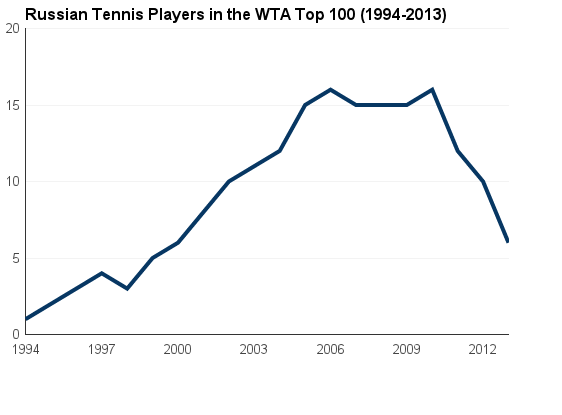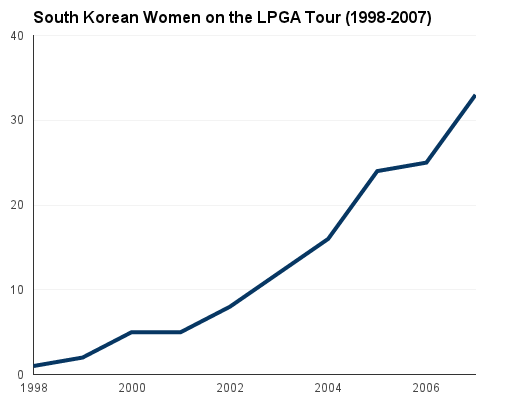“They’re like the goddamned Russian Army. They just keep on coming.” – Nick Bollettieri, tennis coach, commenting on surge of female Russian players

Photo by Two Wings
You may have heard of Anna Kournikova — the former athlete with the supermodel looks who was once married to Enrique Iglesias. But aspiring Russian tennis players knew her for different reasons. In 1998 (at seventeen years old), Kournikova reached the semifinals of Wimbledon, the sport’s most high-profile tournament. Her success led her to millions of dollars of endorsement deals; Kournikova seemingly became an overnight sensation.
In 1998, only three Russian women were in the Women’s Tennis Association’s top-100 (including Kournikova). By 2002, this number had risen to 10. By 2010, 16 Russian players were in the top-100:

Data via WTA Tennis
The Russian dominance of the WTA has diminished a bit in recent years, but there were still 6 Russians in the top-100 this past year.
According to Daniel Coyle, author of The Talent Code, the success of Russian tennis players at least in part stems from Anna Kournikova. Her breakthrough signaled to Russian girls that someone who looks and talks like them can make it big. As Coyle writes:
“What ignited the progress wasn’t any innate skill or gene. It was a small, ephemeral, yet powerful idea: a vision of their ideal future selves, a vision that oriented, energized, and accelerated progress, and that originated in the outside world. [The ignition] sparked an intense, nearly unconscious response that manifested itself as an idea: I want to be like them.”
And in Kournikova’s case, everyone wanted to be like her. Her former coach Larisa Preobrazhenskaya immediately noticed the difference at her tennis academy.
“All the little girls started wearing their hair in pony-tails and grunting when they hit. They were all little Annas.”
A recent Stanford University study sought to look at how powerful success stories really are. Researchers had college freshmen read a series of magazine articles. One of these articles recounted the story of Nathan Jackson. As a college student, Jackson had the ultimate existential crisis– he didn’t know what he wanted to do with his life. However, he grew to love math and went on to have a thriving career in the math department of a university.
Here was the twist: for half of the freshmen in the study, Jackson’s birth date in the article exactly matched the students’.
After reading the articles, the students then worked on a math puzzle given to them by the researchers. They were allowed as much time as they wanted to try and complete the puzzle (though the puzzle itself was impossible to solve– it had no solution).
On average, the students in the same-birthday group spent over 60% more time on the puzzle than the control group:

Data via Stanford University
Students’ self-reported motivation to do math was also much higher for the same-birthday group. Simply learning that Nathan Jackson had the same birthday as them may have caused freshmen to work harder and be more motivated. According to the study’s co-author Gregory Walton, the power of “relatability” is significant:
“They were in a room by themselves taking the test. The door was shut; they were socially isolated; and yet [the birthday connection] had meaning for them. They weren’t alone. The love and interest in math became part of them. They had no idea why. Suddenly it was us doing this, not just me.”
In the same year that Kournikova had her big break-through, another “ignition” moment took place. In 1998, golfer Se Ri Pak won the LPGA Championship, becoming the first South Korean to ever do so. And she was only 20 years old.
In 1998, Pak was the only South Korean golfer on the LPGA Tour. By 2002, there were 12 Koreans; and by 2006, 25:

Data via The Talent Code
By 2008, South Korean golfers had taken over the game: 45 Koreans won over 30% of all LPGA tournaments. How could this sudden increase be explained? Echoing Coyle and the Stanford researchers, Korean-American golfer Christina Kim put it this way:
“I remember watching [Pak] on TV. She wasn’t blond or blue-eyed, and we were of the same blood … You say to yourself, ‘If she can do it, why can’t I?”
So, it seems that role models matter, especially to kids. Those who are interested in getting more female computer programmers and founders should take note. If it works for tennis and golf, why not software engineering?
This post was written by Ammar Mian. Follow him on Twitter here. To get occasional notifications when we write blog posts, sign up for our email list.



